Zotac's Ion: The World's First mini-ITX Ion Board
by Anand Lal Shimpi on May 12, 2009 12:00 AM EST- Posted in
- GPUs
SYSMark 2007 Performance
Our journey starts with SYSMark 2007, the only all-encompassing performance suite in our review today. The idea here is simple: one benchmark to indicate the overall performance of your machine.
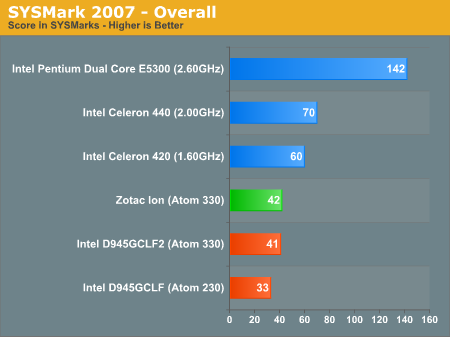
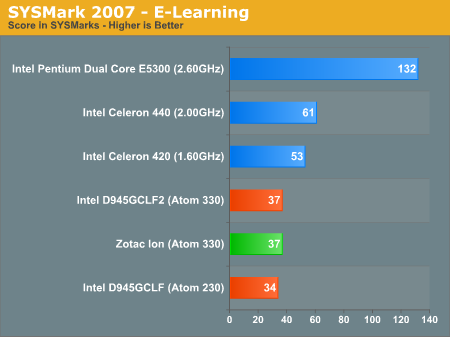

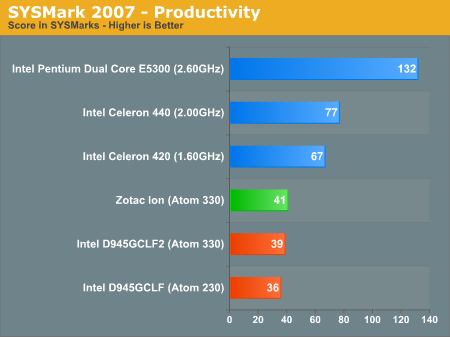
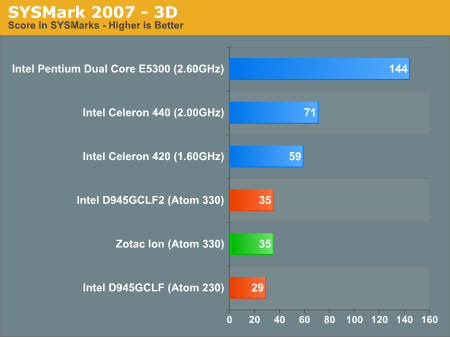
There's a 27% performance improvement realized in SYSMark 2007 when going from the single-core Atom 230 to the dual-core Atom 330. Even the Atom 330 is outperformed by the lowest end Celeron 420 by 43% however.
Note that in general application usage there's no significant performance difference between the Zotac Ion and the Intel D945GCLF2.
And before you get any ideas of replacing a modern day, low-end system with an Ion look at the E5300 score. The E5300 offers 3.4x the speed of the Atom 330. Granted you need a more expensive motherboard but compared to the Zotac Ion, it's not that much more expensive.
Adobe Photoshop CS4 Performance
To measure performance under Photoshop CS4 we turn to the Retouch Artists’ Speed Test. The test does basic photo editing; there are a couple of color space conversions, many layer creations, color curve adjustment, image and canvas size adjustment, unsharp mask, and finally a gaussian blur performed on the entire image.
The whole process is timed and thanks to the use of Intel's X25-M SSD as our test bed hard drive, performance is far more predictable than back when we used to test on mechanical disks.
Time is reported in seconds and the lower numbers mean better performance. The test is multithreaded and can hit all four cores in a quad-core machine.
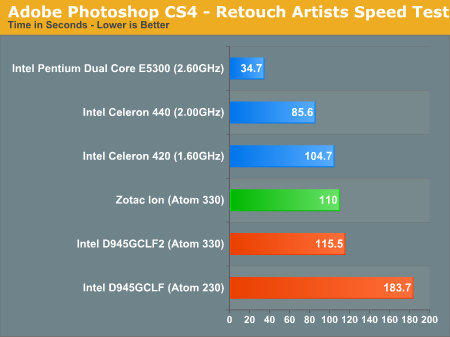
This test was particularly surprising, because with four threads the Atom 330 is able to actually come within striking distance of the Celeron 420's performance - at a considerably lower power consumption. Once we transition to an even more multi-threaded environment where multi-core processors can always maintain a significant performance advantage over their single core brethren then it may be more efficient to toss a few Atom-cores at a problem than something like the Celeron 420. Hmm, perhaps Larrabee will be more useful than we thought...
The single-core Atom 230 is horrendously slow in this test. While the 330 could masquerade as a very low end microprocessor from the modern era, the 230 takes significantly longer to complete our test. No thanks.
The difference between Ion and the D945GCLF2 is negligible.










93 Comments
View All Comments
Badkarma - Wednesday, May 13, 2009 - link
Thanks Anand, will definitely drop you a note regarding this over the weekend. It's quite unfortunate that Zotac left out Wake-On-USB for their 9300/9400 mobos, something many consider essential in an HTPC build.djc208 - Tuesday, May 12, 2009 - link
If I didn't have so many projects already I'd seriously consider one of these as the basis of a CarPC system. It's not cheap but a good touchscreen car monitor will run you far more.NNix - Tuesday, May 12, 2009 - link
On page 5: "Once more, the Pentium 4 gets beat by the Atom 330 but loses to the Atom 230"I hope you will review Cortex A8-based Netbooks once they show up. Because Im not impressed at all with Atom, not when looking at <45W dualcore Athlons. Taking into account that those are at 65nm aswell the Atom aint looking that efficient.
nubie - Tuesday, May 12, 2009 - link
I would take a Celeron 420 any day of the week over an Atom or a dualcore athlon ;)GaryJohnson - Tuesday, May 12, 2009 - link
Celery is for eating, not computing.nubie - Wednesday, May 13, 2009 - link
"Celery is for eating, not computing."Sorry, let me be perfectly clear, I would like a Core2 Conroe-L from 1.6-2.0 ghz (every one I have used will easily go over 3 ghz with no voltage increase)
Look at the raw numbers between the Atom and the Conroe-L and tell me on a desktop/stationary machine (IE not a netbook) you wouldn't rather have something more than twice as powerful.
I realize it is called a "celeron", but it is the most freaking powerful (Core2 architecture) Celeron ever sold.
They cost $25-35 on ebay, the LGA 775 version of this board is only $139. It makes a whole lot of sense if you don't plan on running it on battery power.
Not to mention you can move all the way up to a Quad if you want, but a $60 e5200 2.5ghz 2MB Level 2 Cache seems like a perfect match.
Oh, and you get a PCI-e 2.0 X16 slot :P http://www.newegg.com/Product/Product.aspx?Item=N8...">http://www.newegg.com/Product/Product.aspx?Item=N8...
For $10 more it makes a whole lot of sense. (If you already have the LGA 775 chip laying around it makes even more sense.)
npp - Tuesday, May 12, 2009 - link
What could have made this board perfect is a PCI-E slot to stick some decent audio in. Anyone seen mini PCI-E sound cards around :)Visual - Wednesday, May 13, 2009 - link
Why would you want a sound card for any computer made in the last 10 years? Even with the fanciest card, there would not be even one bit of difference on the digital outputs, which are the ones you should be connecting to your receiver. On the analog outputs there will be quality differences indeed, but if you're using them you deserve what you get :p Besides, I get the feeling you wouldn't notice the difference anyway as if you're that stupid to be using them you are also probably using some crappy speakers.flipmode - Tuesday, May 12, 2009 - link
"Everyone seemed to want a Ion based motherboard after I first previewed the platform."Yeah, it is all because of you :roll:
Is that x264 encoding that you used to test power consumption? Why that? The most power draw likely comes from the chipset. Test Blu-Ray playback or something.
Pandamonium - Tuesday, May 12, 2009 - link
The first comment was pretty rude and uncalled for, I must say.I wanted to see an Ion-based HTPC after the preview and this article confirmed that an Ion-based HTPC is what I should set my sights on next. The only improvement Zotac could have made is to include a PCIe slot for TV tuners, audio, or beefed up video. A higher rated Atom would be nice too, but I don't even know that one exists.